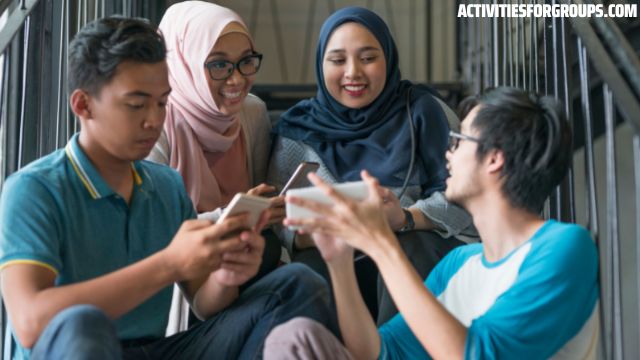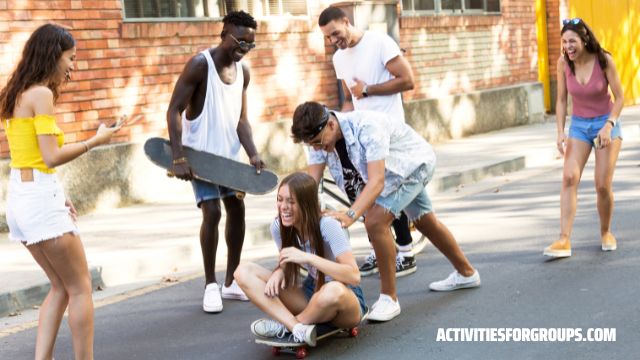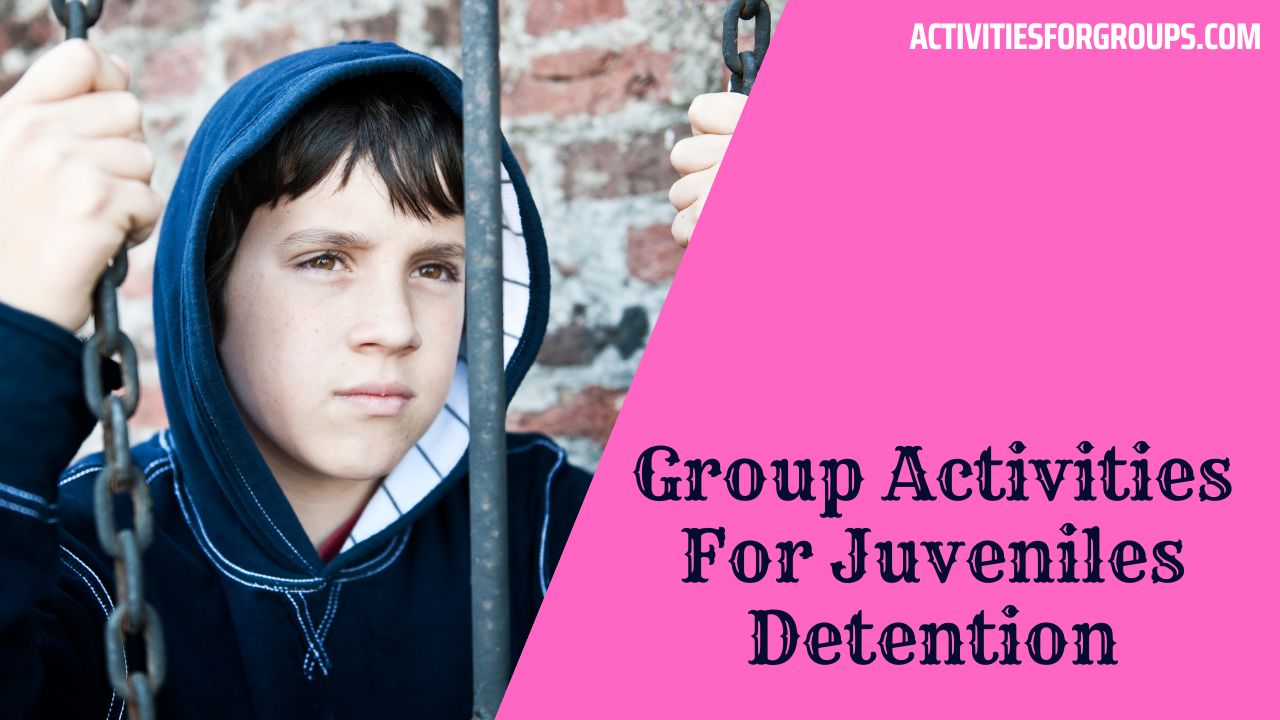Group activities for incarcerated youth can be a great way to keep them engaged and learning while they are in custody. As an experienced Group activities organizer, I know that engaging in activities can help young people develop important skills and create meaningful connections with each other.

It’s my mission to provide fun ways for these teens to interact and learn, no matter their circumstances.
In this article, I’ll offer three ideas for effective group activities that have been successful with incarcerated youth all over the world.
These activities will promote positive social development and teach valuable life skills like communication, cooperation, problem-solving, trust-building, and teamwork. Plus, they’re flexible enough to work with different groups of kids regardless of age or gender composition.
I’m passionate about using creative activities as a tool to foster growth among young people who are struggling with tough circumstances outside their control. Read on to discover more about how you can use these enjoyable yet educational group activity ideas in your own setting!
Also Read – Group Activities For Values Learning – Ideas For All Ages.
Definition Of Incarcerated Youth
Incarcerated youth are those who have been arrested, detained in a juvenile detention center or prison, and/or convicted of criminal offenses. These young offenders may be between the ages of 8-17 years old, depending on their state’s laws.
Generally, they live in secure facilities with limited access to family members and other adults outside the institution. They also receive specialized education and social services from staff within the facility.
The term “youth incarceration” is used to refer specifically to institutionalized settings for these incarcerated minors. Youth prisons provide them with supervision, security, medical care, mental health treatment, and educational opportunities during their stay there.
It can often involve some form of court-ordered restriction such as probation or parole that juveniles must adhere to when released back into society.
Imprisoned youth face greater challenges compared to adults due to their age and developmental stage; thus requiring special activities tailored towards helping them reintegrate back into society after serving their sentence.
With this in mind, it is important that group activities be provided by professionals trained in working with this population so they can benefit from engaging in positive interactions while learning the life skills needed upon release. Moving forward then, let us explore the benefits of group activities for incarcerated youth…
Benefits Of Group Activities

Now that we understand the definition of incarcerated youth, let’s explore the benefits of group activities for them. Group activities can have a powerful social impact on young people who are facing incarceration. By engaging in collaborative activities with other individuals, they can foster positive relationships and learn how to interact more effectively with others.
These types of experiences also offer an opportunity for emotional development. Incarcerated youth may benefit from developing trust between one another as well as better problem-solving skills through working together to complete projects or tasks. In addition, participating in groups often encourages increased self-awareness and greater levels of personal responsibility by learning to accept feedback from peers and adults.
Group activities can also help improve mental health among incarcerated youth by giving them the chance to express their feelings in a safe environment. Participating in this type of activity is believed to reduce stress while providing opportunities to practice new behaviors and coping strategies. Experiencing success in these activities, it may boost self-esteem and confidence which can lead to improved behavior overall.
Engaging in organized recreational activities offers numerous benefits for incarcerated youth whether it be physical fitness, intellectual stimulation, team building, or communication skills; all essential components for leading successful lives after release from their sentences.
Types Of Recreational Activities

The types of recreational activities available to incarcerated youth are vast and varied. An example is the case study of the program at San Quentin State Prison in California which offers a variety of leisure activities for inmates, including outdoor sports such as basketball, volleyball, and soccer; music activities like band practice or karaoke; craft projects such as woodworking or painting canvases; and food-related activities like cooking classes or baking competitions.
These recreational activities can help incarcerated youth develop social skills by teaching them how to work together with their peers in a productive way. They also offer an opportunity for learning new hobbies, building self-confidence, and developing a sense of pride in achieving something positive.
Here’s a list of some activity ideas that could be included in any group session:
- Outdoor Activities – Hiking, camping trips, team sports
- Leisure Activities – Puzzles & board games, movie nights
- Music Activities – Choir practices, guitar lessons
- Craft Projects – Woodworking & crafts workshops
- Food Activities – Baking contests & cooking classes
These activities provide not only physical stimulation but mental engagement as well. By participating in these different types of recreational programs, young adults in detention centers have access to meaningful experiences they otherwise might not have had while locked away from society.
Through these activities, they learn valuable life skills that will ultimately serve them better when it’s time to reenter the community upon release from prison. Moving on to providing social and emotional support…
Social And Emotional Support
The social and emotional support of incarcerated youth is a crucial part of creating a successful environment for healing. Mental health interventions, such as psychological counseling, can help young people work through the trauma they experienced leading up to their incarceration and during it.
Additionally, programs that focus on the promotion of positive emotions and behavioral management strategies are important components in fostering an emotionally supportive group atmosphere.
| Intervention | Goal |
|---|---|
| Mental Health Support | Address Trauma Experienced |
| Psychological Interventions | Foster Emotional Wellbeing |
| Emotional Regulation Programs | Develop Healthy Coping Skills |
| Behavioral Programs | Increase Positive Behaviors |
Activities like role-playing scenarios or journal writing can be used in sessions with inmates to practice these skills. Group activities should also involve discussions about mental health topics, including self-care and strategies for managing stress.
Participation in art projects which allow individuals to express themselves creatively can also increase feelings of self-worth and encourage open communication between peers.
Overall, providing social and emotional support within a correctional setting helps create safe spaces for learning new coping mechanisms and building life skills necessary for success outside of prison walls.
Education And Learning Opportunities

Having a good education is like having wings to soar. It provides youth with the knowledge, skills and confidence needed for success in life. Incarcerated young people often don’t have access to quality educational programming, learning resources, or academic support – but there are many ways we as group activities specialists can help them unlock their potential.
We should provide opportunities that focus on developing the necessary skills they’ll need to succeed both inside and outside of prison walls. Here are some ideas:
- Educational Materials: Provide incarcerated youth with age-appropriate textbooks, worksheets, activities, and exercises so they can continue their studies while incarcerated.
- Study Groups: Create study groups amongst peers who share similar interests and goals; this helps build confidence, fosters relationships among participants, and encourages critical thinking.
- Academic Support: Offer tutoring services from professionals who specialize in teaching at-risk students; these services could include one-on-one sessions or group workshops focusing on specific topics such as mathematics or English literature.
By providing these types of educational programs, we’re helping empower our incarcerated youths to become successful learners who can take charge of their lives when released back into society. We must equip them with the tools that will enable them to reach their fullest potential no matter what obstacles stand in their way!
With increased access to educational materials, study groups, and academic support, we can make an impact on the next generation’s future by instilling strong values that promote self-sufficiency and resilience within our youth population.
From here we move on to Life Skills Development which further builds upon our efforts towards giving every young person a better chance at success!
Life Skills Development

Moving from education and learning opportunities to life skills development, we can provide incarcerated youth with a variety of activities that help develop their self-sufficiency. Through these activities, they will gain confidence while also developing important coping strategies, decision-making abilities, problem-solving techniques, and communication skills.
One such activity could be having the group create a ‘Life Skills Toolbox’ through which different topics related to successful personal management can be discussed in depth. This could include setting goals, time management, managing stress levels, or financial literacy. Each topic should emphasize practical solutions for real-life scenarios – enabling young people to feel empowered when facing difficulties outside of incarceration.
Other great activities include creating an action plan on how each individual can become more independent once released. This would involve goal mapping; helping them figure out what steps need to be taken toward achieving their aspirations.
It is not enough to just list down ambitions, it’s equally important to explore ways in which those dreams can be achieved within certain boundaries – whether that’s limited resources or legal restrictions. With this type of activity, youths learn how to navigate obstacles and build assertiveness as well as resilience in order to reach success both during and after incarceration.
These activities are designed so that participants have fun while gaining life lessons they may otherwise lack access to due to their circumstances – allowing them greater control over their lives regardless of any limitations imposed upon them by the criminal justice system.
As we move forward into discussing mentoring programs, these valuable skills developed here will prove even more beneficial for our juveniles going forward.
Mentoring Programs

Mentoring programs are the silver lining that can light up incarcerated youth’s lives, offering them a path to self-growth and development. These programs provide invaluable access for mentors and mentees to create meaningful connections with each other in order to foster trust and teach important life skills.
| Programs | Description |
|---|---|
| Mentors Incarcerated | Provide inmates with an opportunity to mentor peers |
| Prisoner Development | Develop leadership within prisoners |
| Mentoring Incarcerated | Support growth of peer relationships |
| Arts & Culture Outreach | Empowering cultural expression through art |
By providing unique opportunities like these, incarcerated youths receive a valuable source of support as they work on their rehabilitation journey.
Through developing strong interpersonal bonds between mentors and mentees, individuals emerge from prison better equipped to face the challenges ahead while being able to take greater ownership of their lives. Moreover, it is also an opportunity for prisoners to learn from one another and acquire new tools for problem-solving outside the walls of the correctional institution.
Read Also – 23 Group Activities Ideas For Problem-Solving.
With such initiatives in place, we have seen remarkable changes among inmates who engage in this type of program – may feel more connected with society instead of isolated and disconnected as before.
The impact goes beyond just personal transformation; by allowing formerly incarcerated people to make these kinds of contributions back into their communities, everyone benefits from increased safety, stability, and economic well-being.
Arts And Cultural Participation

For incarcerated youth, involvement in the arts and culture can be a great way to stay connected to their communities. It allows them to express themselves creatively, find novel views, and grow in their appreciation of the arts.
The activities should foster inclusivity and emphasize creativity as opposed to technique or technical skill. Arts-based initiatives could include pottery classes, music production workshops, theater performances, mural painting sessions, photography projects, and more.
Many art forms are accessible even within prison environments; however, there may be restrictions on what materials inmates have access to. Fortunately, there are many creative solutions that can help bring artistic expression into confined settings such as using paper cutouts instead of paints or creating instruments out of recycled materials like tin cans or plastic bottles.
Additionally, digital tools such as iPads allow for easy recording capabilities so prisoners can make use of technology when available. With thoughtful planning by activity coordinators and support from local organizations, these efforts can lead not only to personal growth but also build community connections and relationships between inmates and the outside world.
These activities provide an invaluable opportunity for learning about different cultures while allowing young people who are often isolated from their peers the chance to connect with each other through shared experiences.
By encouraging participation in cultural programming opportunities, we can open up channels of communication between those inside correctional facilities and others on the outside helping bridge gaps caused by incarceration as well as create meaningful dialogue around issues related to criminal justice reform.
As we move forward towards sports and exercise initiatives for incarcerated youth, it is important to remember that providing safe spaces where young people feel heard can have lasting positive impacts far beyond any given project or program’s time frame.
Sports And Exercise Initiatives
Sports and exercise initiatives can be incredibly beneficial for incarcerated youth. Physical activity has been found to help improve not just physical health, but also mental well-being and social development.
Group activities that involve sports and exercises are therefore an important part of any group initiative with the goal of providing positive experiences for young people in detention centers.
Below is a list of possible sport-based activities:
- Outdoor team games such as volleyball or soccer
- Individual fitness challenges like running or jump rope competitions
- A variety of traditional sports such as basketball or badminton
- Yoga classes as well as meditation practices
In order to keep everyone motivated, it’s important to provide incentives and rewards for participation. Prizes could include special snacks, new books or magazines, extra phone call time with family members, etc. It will also be necessary to monitor detained youth’s performance levels so they do not overexert themselves while engaging in physical activity.
The benefits of incorporating sports into group activities for incarcerated youth go beyond just physical fitness; it helps build confidence, increases self-esteem, provides a sense of purpose, creates bonds between participants, and encourages leadership skills.
With these advantages in mind, transitioning into technology-based activities may prove even more effective in fostering meaningful relationships among the detainees.
Technology-Based Activities
Technology-based activities provide an exciting opportunity for incarcerated youth to explore their interests and discover new talents. With the right guidance, these youths can use technology as a tool to develop skills that will benefit them both now and in the future.
The possibilities are virtually limitless with virtual reality, gaming consoles, online classes, video production, and robotics programs all accessible within correctional facilities.
First off is virtual reality; this technology offers a truly immersive experience where inmates can learn about different cultures or even take up a career path like carpentry or engineering.
This type of activity provides an escape from the daily routine of prison life while also helping to stimulate critical thinking skills and creativity. Additionally, it gives inmates access to information that could otherwise be difficult to gather inside prison walls.
Gaming consoles offer another form of group activity by allowing multiple participants simultaneously engage in various types of games — sports titles, puzzle games such as Tetris, fighting games, and more.
These activities help foster team building amongst inmates while providing entertainment during free time hours. Moreover, playing console games helps sharpen cognitive abilities since they often require mental agility and strategy development when overcoming obstacles throughout gameplay sessions.
Finally, there are plenty of options available when it comes to teaching inmates how computers work through hands-on learning experiences via tutorials on coding languages or web design projects using HTML & CSS programming techniques.
Inmates can also participate in online courses related to specific topics they’re interested in exploring further such as music theory or graphic design software applications like Adobe Photoshop/Illustrator.
Video production classes give individuals the chance to express themselves creatively by producing short films with equipment provided by correctional institutions – perfect for those who want to showcase artistic talent! Robotics clubs complete this list of tech-engaging activities giving members the opportunity to develop problem-solving strategies through interactive simulations involving robots programmed for certain tasks set by facilitators.
In summary: Technology-based activities have much potential for incarcerated youth – from immersing them into other worlds via virtual reality headsets all the way down to honing technical skills with robotics clubs – all designed so that each participant has something fun but meaningful to do every day
Frequently Asked Questions [FAQs]
What Is The Average Age Range Of Incarcerated Youth?
The age range is one of the most crucial factors to take into account when talking about juvenile offenders. In order to properly organize activities and programs suited to the requirements of imprisoned youth, a youth group activity expert must be aware of the typical age range of the population. We’ll talk about the usual age range of youth incarceration in this piece.
The typical age of prisoners differs from nation to nation, but research has shown that most nations follow similar patterns when it comes to locking up minors under the age of 18.
In terms of U.S specific figures, research indicates that approximately half (50%) of individuals jailed in America are below 25 years old, while two out of five (40%) are younger than 21 years old – meaning they were too young at the time they committed their crime and sentenced accordingly as minors. Additionally, statistics show that African American males comprise a disproportionate number within this demographic – making up only 8% percent of the US population but 33% percent of those under correctional control or supervision.
These numbers demonstrate just how critical it is for us as youth group activity specialists to be aware about who we’re working with so that our programming can match these demographics effectively – ensuring each participant has access to meaningful opportunities and experiences regardless of their background or circumstance.
What Safety Measures Are Taken To Ensure The Safety Of The Incarcerated Youth During Group Activities?

When it comes to group activities for incarcerated youth, safety measures are of utmost importance.
The average age range of those involved is typically between 12 and 24 years old, so extra caution must be taken when organizing activities that involve this vulnerable population.
Group activities provide an opportunity for rehabilitation and development outside of the prison setting. To make sure that all participants are safe during any initiative, organizations need to thoroughly plan out each event before implementation.
This includes ensuring adequate supervision from trained professionals or volunteers, as well as providing appropriate medical help if needed. All associated costs should also be considered ahead of time, such as transportation needs or supplies required for a particular activity.
I have worked with many different institutions throughout my career who prioritize safety above all else when planning activities for their incarcerated youth populations.
They understand that without proper risk assessment and safety protocols in place, there can be serious consequences both to the individual at hand and society overall. It is essential that we create a secure environment where young people have the chance to take part in meaningful experiences while still under the care and guidance of responsible adults.
Are There Any Restrictions On The Types Of Activities Incarcerated Youth Can Participate In?

When it comes to group activities for incarcerated youth, one of the most important questions that needs to be asked is: are there any restrictions on the types of activities these youths can participate in? It’s crucial that activity specialists and facilitators consider all safety requirements as well as potential costs associated with any proposed initiatives.
The safety of incarcerated youth must always remain a top priority when planning group activities. Activity specialists need to carefully evaluate each activity before allowing incarcerated youth to take part. Guidelines should be established regarding what kinds of activities are suitable, and all participants should abide by those rules.
Furthermore, successful initiatives should include oversight from supervisors or staff members who will help ensure the safety of everyone involved.
In addition to safety concerns, it’s also necessary to look at cost-related factors when designing activities for incarcerated youth groups. Depending on the size and scope of the project, specialized equipment may need to be purchased or rented; moreover, if an outside location is chosen for an activity, transport may have to be arranged. All of this requires careful planning and budgeting so that appropriate resources are allocated for safe, enjoyable experiences for the group.
At the end of the day, providing meaningful group activities for incarcerated youth means taking into account not only their safety but also financial constraints and other relevant considerations too! By ensuring a balance between these different elements, youth groups will benefit from engaging in positive recreational opportunities while still receiving adequate supervision during their time together.
Are There Any Successful Group Activity Initiatives That Have Been Implemented In Other States?
When considering group activities for incarcerated youth, it is important to explore successful initiatives implemented in other states. As a youth group activity organizer, I am committed to ensuring safety and providing meaningful experiences for all participants.
It is essential to evaluate the various group activity initiatives used by correctional facilities across different states when coming up with ideas. It can be helpful to research what has been working well in other locations and adapt those measures to your own program design.
For example, some states have developed unique programs that provide educational opportunities such as tutoring or writing workshops while others may focus more on physical activities like yoga or sports leagues. Regardless of the type of initiative chosen, it should always include clear parameters around safety measures and expectations for the participants.
In addition to researching best practices from other states, there are also resources available online where you can look at examples of effective strategies that have proven successful with incarcerated youth.
These samples can serve as templates which you can modify based on the needs of your specific facility. By utilizing these resources, you will gain valuable insight into how to create an engaging experience with appropriate safety protocols in place for everyone involved.
Creating a fun and safe environment for incarcerated youth requires thoughtful planning and exploring successful group activity initiatives from other states is essential for designing an impactful program that meets their needs.
With careful consideration given to both existing regulations and recommended guidelines, any initiative can be tailored to ensure security and enriching outcomes for all participants alike.
Are There Any Costs Associated With Participating In Group Activities For Incarcerated Youth?

When considering group activities for incarcerated youth, one of the most important factors to consider is the costs associated with participating. Depending on the activity and its scope, there can be a wide range of cost considerations that must be taken into account:
- Material expenses such as supplies or equipment needed
- Transportation costs if trips are involved
- Costs related to hiring facilitators or volunteers
- Administrative overhead like printing costs or online tools
As a group activity organizer, it’s my job to ensure these financial concerns don’t prevent detained youths from accessing meaningful experiences through structured activities. That means making sure all stakeholders have access to accurate information about what funds are available and how those resources should best be allocated. I take great care in analyzing each individual situation so that we can maximize our impact without going over budget.
To do this effectively, I work closely with correctional facility staff members who understand their local context, whether it’s limited resources or specific regulations that need to be taken into consideration. By partnering up in this way, we can create effective strategies for covering any associated costs while providing quality activities for classrooms and other groups of detained youths.
It’s not always an easy task but when done right, everyone benefits – both financially and otherwise –from well-planned group activities tailored specifically to meet the needs of the incarcerated youth population.
Conclusion
The typical age of detained juveniles must be taken into account, as well as any necessary safety precautions. In order for these young people to engage in meaningful activities, it is also essential to guarantee that there are no restrictions on those activities.
Finally, it’s essential to keep costs low so more incarcerated youth can participate and benefit from group activities.
Ultimately, I believe providing effective group activities is one of the most powerful tools available when working with incarcerated youth. Through engagement with peers and supportive adults, these young individuals will gain valuable skills such as communication, problem-solving, teamwork, resilience, and empathy. As a result of participation in organized activities, hopefully, we’ll see improved behavior within correctional facilities across the country.
In conclusion, by giving incarcerated youth access to appropriate group activities we’re offering them a chance to grow emotionally and build relationships outside of their current circumstances. This type of support has invaluable potential—not just while they’re in prison but even after they’ve been released into society.




Leave a Reply